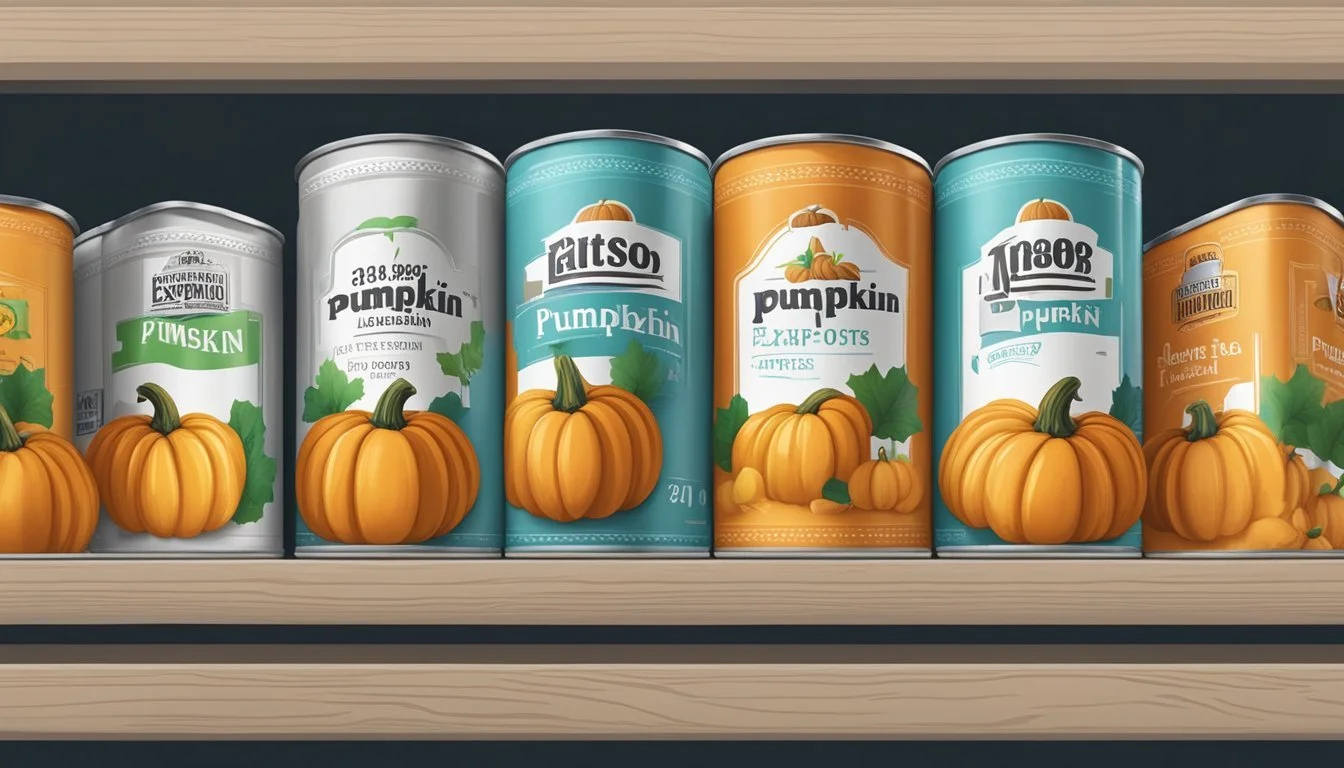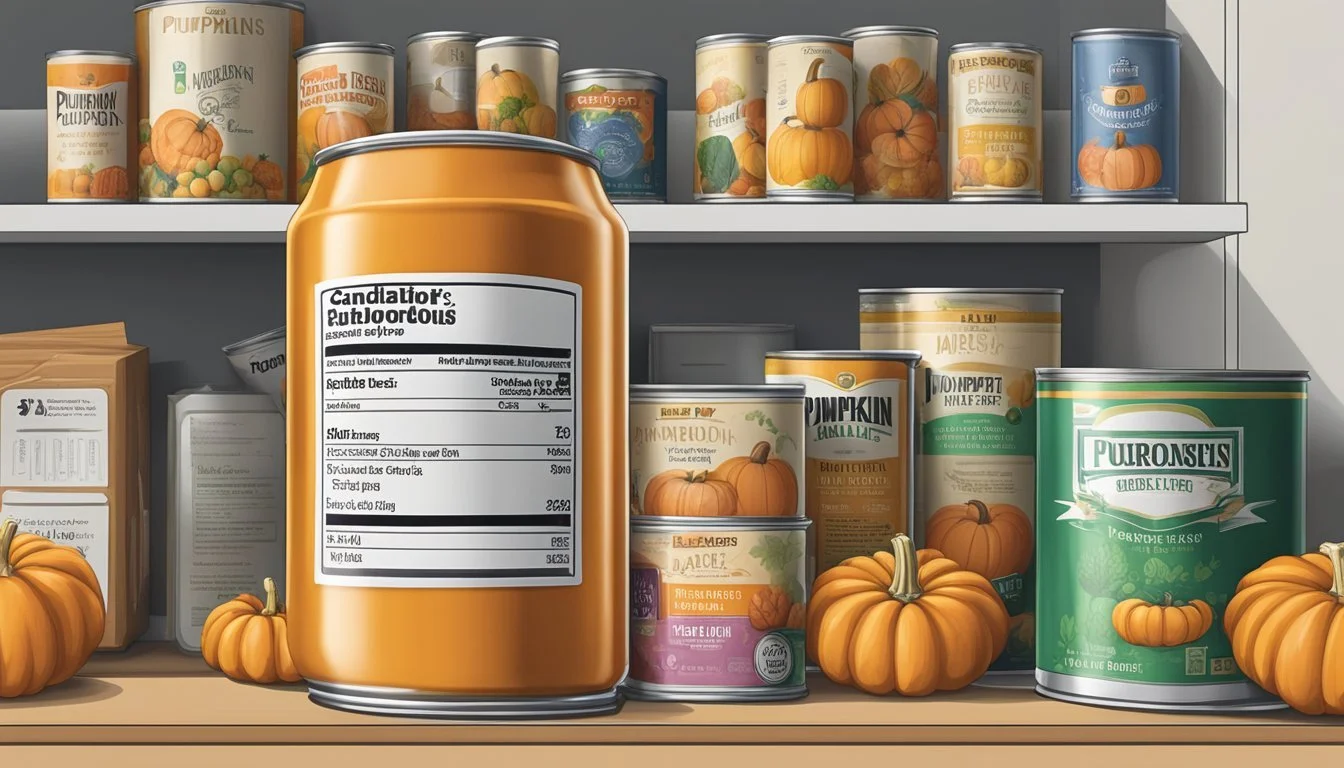Does Canned Pumpkin Expire?
Essential Shelf-Life Information
Canned pumpkin is a popular ingredient in many kitchens, especially during the fall season. Many people wonder about its longevity and safety. The shelf life of unopened canned pumpkin can extend up to 3 to 5 years if stored in a cool, dry place. This ensures that it remains safe to eat and retains its quality over time.
Once the can is opened, it’s crucial to handle any unused portion properly. Transfer it to an airtight container and store it in the refrigerator to maintain its freshness. Using it within a few days is recommended to prevent spoilage and ensure it adds the best flavor and texture to your dishes.
Food safety is essential when dealing with expired canned goods. Over time, even canned pumpkin can deteriorate, potentially posing health risks if consumed when spoiled. Look out for changes in color, texture, or smell to gauge its quality before use.
Understanding Canned Pumpkin
Canned pumpkin, including pumpkin puree, is a nutrient-rich food option available year-round. This section explores what canned pumpkin is, its nutritional value, and the canning process, including the use of preservatives.
What Is Canned Pumpkin
Canned pumpkin is a convenient form of pumpkin that is often used in various recipes. It typically consists of plain pumpkin puree, which is made by cooking and mashing the flesh of pumpkins.
Unlike fresh pumpkins, canned pumpkin is available all year and requires no preparation, making it a popular choice for cooks. Commonly, it is found as either pure pumpkin puree or pumpkin pie filling, the latter of which may include additional spices and sugar.
Nutritional Value of Canned Pumpkin
Canned pumpkin is nutrient-rich and offers several health benefits. It is an excellent source of dietary fiber, which assists in digestion and promotes satiety. Additionally, canned pumpkin contains significant amounts of vitamins and minerals.
Key Nutrients in Canned Pumpkin:
Vitamin A: Essential for eye health and immune function.
Vitamin C: Provides antioxidant benefits, aiding in skin health and immune support.
Potassium: Helps regulate blood pressure and muscle function.
Iron: Vital for oxygen transport in the blood.
In terms of calorie content, canned pumpkin is relatively low, making it a healthy addition to various dishes without adding excessive calories.
Canning Process and Preservatives
The canning process of pumpkin helps preserve its freshness and nutritional content for an extended period. Fresh pumpkins are cleaned, peeled, cooked, and then pureed before being sealed in sterilized cans.
In the process, preservatives might be added to enhance shelf life and maintain quality. Most commercially available canned pumpkin contains minimal preservatives due to the natural preservation method provided by the canning process.
By being stored properly in a cool, dry place, canned pumpkin can maintain its quality for 3 to 5 years. This long shelf life is one of the main advantages, making canned pumpkin a versatile and convenient pantry staple.
Shelf Life and Expiration
The shelf life of canned pumpkin can vary based on storage methods, manufacturer's estimates, and the differences between peak quality and food safety.
Manufacturer's Estimate and Expiration Date
Manufacturers typically estimate the shelf life of unopened canned pumpkin to be between 3 to 5 years. The expiration date printed on the can is not always an indicator of safety but rather the period during which the product is expected to retain its best quality.
The USDA states that canned goods generally have a long shelf life. A "best by" or "use by" date often serves as a guideline for optimal quality.
Peak Quality vs. Food Safety
Peak quality refers to the time frame when canned pumpkin will have the best taste and texture. After the expiration date, while the canned pumpkin may still be safe to eat, its quality might decline. Flavors might be less robust and texture may change, but the product will remain safe if the can is undamaged and stored properly.
Remember, food safety does not decline immediately after the expiration date. Conditions such as being stored in a cool, dry pantry will ensure that the canned pumpkin remains safe for consumption even beyond the labeled date.
Factors Affecting Shelf Life
Several factors affect the shelf life of canned pumpkin. Storage conditions play a crucial role. The can should be kept in a pantry or another cool, dry location. Exposure to heat, moisture, or direct sunlight can decrease its shelf life.
Temperature fluctuations can also impact the longevity of the product. A consistent, room temperature environment is ideal.
Proper storage ensures the product remains both safe and of high quality. Familiarity with these factors can help consumers make informed decisions and maintain the quality of their canned pumpkin for as long as possible.
Storage Guidelines
Proper storage of canned pumpkin, whether unopened or opened, is essential to maintain its quality and safety. Additionally, freezing provides an alternative for extending the shelf life of opened canned pumpkin.
Storing Unopened Cans
Unopened canned pumpkin should be stored in a cool, dry place, such as a pantry or a cabinet. The ideal environment is at room temperature, away from direct sunlight and heat sources, which can degrade the quality of the pumpkin.
Shelf life: If stored correctly, unopened canned pumpkin typically stays at its best quality for about 3 to 5 years. Although the flavor and texture may start to deteriorate after this period, the pumpkin usually remains safe to consume.
It is vital to ensure that the can is undamaged. Dents, rust, or swelling can indicate compromised safety and quality.
Storing Opened Cans
Once a can of pumpkin is opened, any unused portion needs immediate transfer to an airtight container. This practice helps prevent exposure to air and contaminants, which could lead to spoilage.
Opened canned pumpkin should be refrigerated and used within 5 to 7 days for optimal freshness. Labeling the container with the date can help track its freshness.
Avoid leaving the pumpkin in the original can, as this can affect the taste and safety of the product over time.
Freezing Canned Pumpkin
Freezing is an excellent way to extend the shelf life of opened canned pumpkin. Transfer the remaining pumpkin to an airtight container or a freezer-safe bag.
Before freezing, remove excess air from the bag to prevent freezer burn. Frozen canned pumpkin can last for up to 3 months.
Thawing: When ready to use, thaw the pumpkin in the refrigerator overnight. Once defrosted, it is best to use the pumpkin within a few days for the best results.
By following these storage guidelines, it is possible to enjoy canned pumpkin for an extended period without compromising quality or safety.
Identifying Spoiled Canned Pumpkin
Ensuring canned pumpkin hasn't gone bad includes checking for changes in appearance, smell, and can integrity. These indicators help prevent consuming spoiled pumpkin which can lead to foodborne illnesses.
Visual and Texture Clues
Spoiled canned pumpkin often shows signs of discoloration or mold growth. Fresh pumpkin should have a consistent orange color. If the pumpkin appears darker or exhibits unusual colors like brown or black, it may be spoiled.
Mold can appear as fuzzy spots or patches. Texture changes can also indicate spoilage. Fresh canned pumpkin is usually smooth and thick. If it becomes watery, excessively thick, or grainy, it should be discarded. These visual and textural changes suggest bacterial growth.
Odor and Taste Assessment
Odor is another crucial indicator. Fresh canned pumpkin has a mild, slightly sweet smell. Spoiled pumpkin typically emits an off odor or sour smell. Any hint of an unpleasant or fermented scent is a sign of spoilage.
When it comes to taste, a small, cautious taste test can be done if there are no visual or odor changes. Fresh pumpkin will taste sweet and earthy. If the flavor is off, sour, or bitter, it is best not to consume it. An off taste indicates that spoilage has occurred.
Can Integrity
The condition of the can itself can also signal spoilage. Check for bulging sides or ends. A bulging can suggests gas build-up from bacterial activity, indicating spoilage. Leaking, rusting, or dented cans can also compromise the safety of the pumpkin inside.
A leaking can clearly shows that the seal has been broken, allowing contaminants like bacteria to enter. Rust can penetrate the can, contaminating the contents. Dented cans are at higher risk of having compromised seals, leading to potential spoilage. Always inspect the can before using the pumpkin.
Using Canned Pumpkin in Recipes
Canned pumpkin is a versatile ingredient that can be used in both sweet and savory recipes. It’s essential to know how to store, prepare, and use canned pumpkin to ensure the best quality and flavor in your dishes.
Culinary Applications
Canned pumpkin shines in various recipes. It is a staple in classic dishes like pumpkin pie and pumpkin soup, providing a rich and smooth texture. Additionally, it adds moisture to baked goods such as muffins, pancakes, and cookies.
It can also be used in smoothies for added nutrition and a creamy consistency. Because it can be used both in savory soups and sweet pies, keeping a can in the pantry ensures that a diverse range of meals can be prepared at any time.
Thawing and Preparing Defrosted Pumpkin
If you’ve frozen leftover canned pumpkin, proper thawing is crucial to maintaining texture and taste. Move it from the freezer to the refrigerator, allowing it to thaw slowly, which helps preserve its quality.
Once defrosted, any separation in the pumpkin should be corrected by stirring. Before adding to recipes, ensure it's at room temperature to blend seamlessly into dishes. Food safety is paramount; avoid refreezing thawed pumpkin to maintain its safety and quality.
Tips for Best Quality in Dishes
For optimal flavor and texture in dishes, store unused portions of canned pumpkin in an airtight container in the refrigerator. Use within a week to ensure freshness. When cooking, taste and adjust seasoning to complement the pumpkin’s earthy and slightly sweet profile.
For baking, consider reducing other liquids slightly as the puree adds moisture. Combining it with spices like cinnamon, nutmeg, and cloves can enhance its natural flavor, especially in sweet recipes like pies and muffins. Storing unopened cans in a cool, dry place will preserve their quality for a longer period.
Health and Safety Considerations
Safe consumption of canned pumpkin hinges on understanding its shelf life and proper storage practices. Adhering to USDA guidelines ensures that the pumpkin remains safe and nutritious.
Impact of Canned Food on Health
Canned pumpkin is nutrient-rich, offering essential vitamins, fiber, and minerals. When properly stored, it retains these nutritional values. However, quality and safety may degrade over time. Bacteria growth in expired canned food poses a health risk.
Chemical reactions inside the can can alter the pumpkin's taste and texture, signaling spoilage. Using expired canned pumpkin increases the risk of foodborne illnesses, such as food poisoning. Always check for signs of damage or spoilage before use.
USDA Guidelines and Food Safety
The USDA provides specific guidelines to ensure food safety. Unopened canned pumpkin has a shelf life of 3 to 5 years if stored in a cool, dry place, like a pantry. Cans should be undamaged to prevent contamination.
Post-opening, transfer unused canned pumpkin to a sealed container and refrigerate. Use within a few days to maintain its quality and safety. Adhering to these practices helps reduce health risks and preserves the pumpkin's nutritional value. Always inspect cans for dents, rust, or bulges, as these indicate potential safety hazards.






